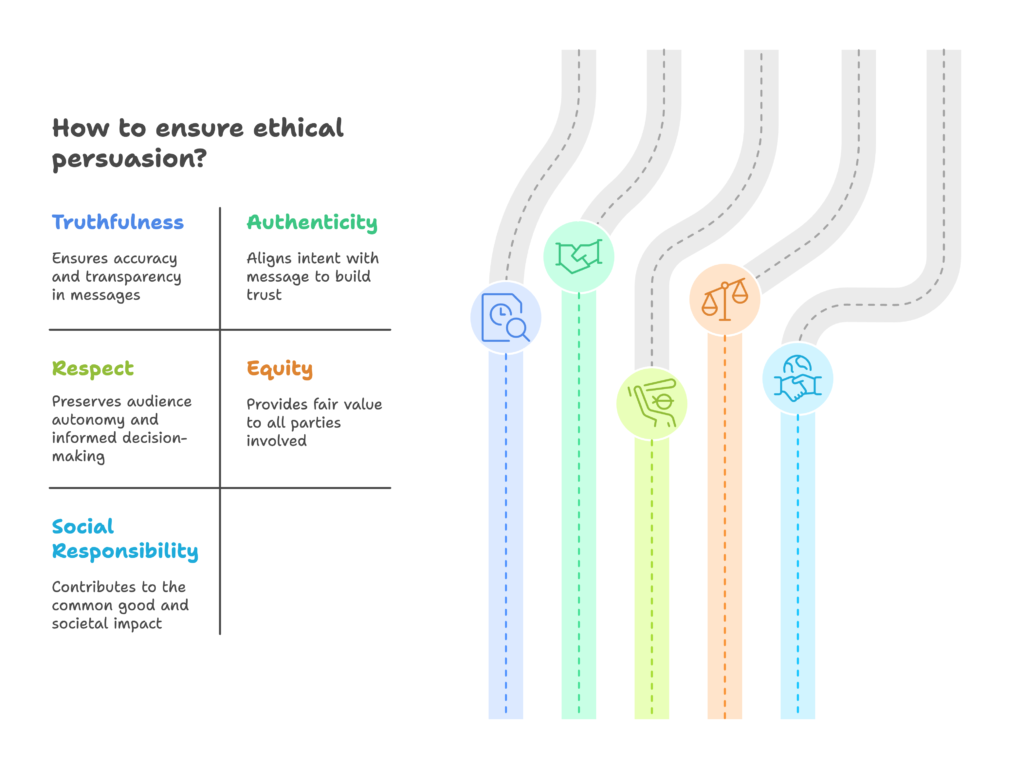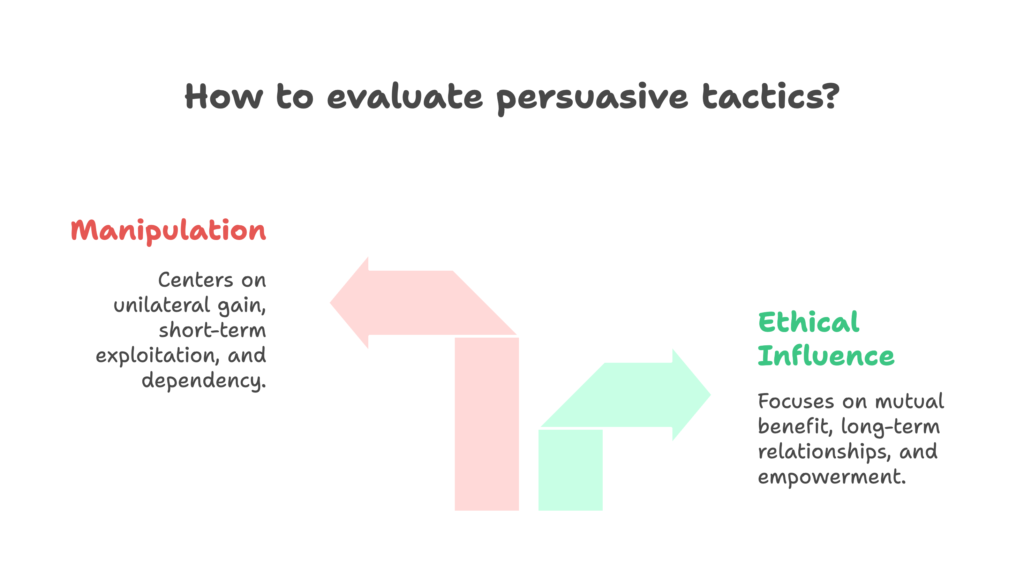Have you ever wondered if that irresistible marketing offer was actually manipulating you? Or maybe you’ve questioned whether your own persuasion tactics cross an ethical line? In a world where influence is currency, understanding the difference between ethical persuasion and manipulation isn’t just interesting—it’s essential. Whether you’re a marketer, business owner, or simply a conscious consumer, this distinction impacts every decision you make and every message you receive.
By reading this article, you’ll discover:
- The clear neurological and psychological differences between influence and manipulation
- A practical framework to evaluate and create ethical persuasion strategies
- Real-world examples of brands that have mastered ethical persuasion
- Tools to measure the ethics of your own persuasive content
Ready to navigate the fine line between helping people make good decisions and manipulating them for your gain? Let’s dive in!
Defining the Ethical Landscape
Before we can discuss strategies and frameworks, we need to establish what we mean by influence versus manipulation. In this section, we’ll explore the fundamental differences between these approaches and how they affect the brain differently.
Core Concepts
At its heart, influence is about affecting decisions through transparent, value-aligned methods. When you influence someone, you’re helping them make a choice that benefits them while also potentially benefiting you—a win-win situation. You’re not hiding information or creating false urgency.
In contrast, manipulation controls outcomes through deception or exploitation. The manipulator prioritizes their own gain, often at the expense of the other person. They might use tricks, hide information, or exploit psychological vulnerabilities to get what they want.
Between these two approaches lies what we call the persuasion continuum—ranging from ethical nudges that respect autonomy to coercive dark patterns designed to trap or trick people into decisions they wouldn’t otherwise make.
Neurological Differentiation
The difference between influence and manipulation isn’t just philosophical—it shows up in our brains. When someone experiences ethical influence, their prefrontal cortex activates, the area responsible for rational decision-making and weighing options. This allows for thoughtful consideration and genuine choice.
Manipulation, however, tends to trigger the amygdala—our brain’s fear center. This creates a fight-or-flight response that bypasses rational thought, leading to impulsive decisions based on fear or anxiety rather than careful consideration.
Similarly, ethical influence often triggers healthy dopamine pathways that reinforce positive decision-making. Manipulation, on the other hand, can create addiction-like dopamine loops similar to gambling, designed to keep people coming back regardless of whether it’s good for them.
Finally, genuine influence fosters oxytocin release, the trust hormone that builds long-term relationships. Manipulative tactics may create short-term compliance through fear or anxiety responses, but they erode trust over time.
Now that we understand what makes influence different from manipulation at both conceptual and neurological levels, let’s explore the ethical principles that can guide our persuasion efforts. After all, knowing the difference is one thing—but having a framework to consistently make ethical choices is where real value lies!
Theoretical Foundations
With a clear understanding of what distinguishes influence from manipulation, we can now explore the theoretical frameworks that help us stay on the ethical side of persuasion. This section introduces key principles and psychological mechanisms that form the foundation of ethical persuasion.

TARES Ethical Principles
The TARES test provides five core principles for evaluating the ethics of persuasive communications:
- Truthfulness: Is your message accurate and transparent? Ethical persuasion never relies on false claims or misleading information. When you present facts, they should be verifiable and presented in context.
- Authenticity: Does your intent align with your message? Your stated purpose should match your actual goals. If you claim to be helping customers solve a problem, that should genuinely be your primary aim.
- Respect: Does your approach preserve audience autonomy? Ethical persuasion respects people’s right to make their own informed decisions without pressure or manipulation.
- Equity: Does the exchange provide fair value to all parties? Both sides should benefit from the interaction, with no one being exploited or shortchanged.
- Social Responsibility: Does your persuasion contribute to the common good? Beyond individual transactions, ethical persuasion considers its broader impact on society.
These principles provide a practical checklist for evaluating whether your persuasive efforts remain on the ethical side of the spectrum.
Psychological Mechanisms
Understanding the psychology behind decision-making helps us create persuasive messages that respect how people’s minds work:
Cognitive dissonance occurs when people hold contradictory beliefs or when their actions contradict their values. Ethical persuasion helps reduce this discomfort by aligning actions with values. Manipulation, however, deliberately induces dissonance to create pressure.
Our brains use two decision-making systems: System 1 (fast, intuitive, emotional) and System 2 (slow, deliberate, rational). Ethical persuasion engages both systems appropriately, allowing for quick understanding followed by thoughtful consideration. Manipulation typically overloads System 1 while preventing System 2 from activating.
Maslow’s hierarchy of needs reminds us that people make decisions based on different levels of needs—from basic survival to self-actualization. Ethical persuasion frames benefits in terms of genuine needs, helping people fulfill their actual goals rather than creating artificial ones.
With these theoretical foundations established, we’re ready to explore exactly where the line between influence and manipulation lies. How can we practically determine whether our persuasion tactics cross into unethical territory? Let’s find out by examining specific markers along the influence-manipulation spectrum.
The Influence-Manipulation Spectrum
Now that we’ve covered the basic principles of ethical persuasion, let’s get practical. How do we know where our tactics fall on the spectrum between influence and manipulation? This section provides concrete frameworks to evaluate the ethics of persuasive approaches.

Intent Analysis Matrix
One of the clearest ways to determine whether you’re influencing or manipulating is to honestly assess your intent using these three dimensions:
- Benefit direction: Ethical influence aims for mutual benefit where both parties gain something valuable. Manipulation focuses on unilateral gain where only the persuader benefits significantly.
- Time horizon: Influence typically prioritizes long-term relationship building over immediate conversion. Manipulation tends to focus on short-term exploitation with little concern for future interactions.
- Impact on autonomy: Ethical persuasion leads to empowerment, helping people make better decisions independently in the future. Manipulation creates dependency, making people less able to make good decisions without the manipulator’s input.
By examining your approach through these lenses, you can quickly identify whether you’re leaning toward manipulation rather than ethical influence.
Behavioral Markers
Beyond intent, specific tactics and behaviors clearly signal where persuasion falls on the ethical spectrum. Here’s a comparison of common approaches:
| Ethical Influence | Manipulation |
|---|---|
| Transparent data use with clear privacy policies | Hidden tracking and undisclosed data collection |
| Value-based scarcity (truly limited resources) | Fake urgency (“Only 3 hours left!” when the offer will be renewed) |
| Informed consent with clear understanding | Coercive defaults that make opting out difficult |
| Presenting complete information, including limitations | Hiding downsides or potential negative outcomes |
| Acknowledging alternatives, including competitors | Presenting false dichotomies that eliminate viable options |
Understanding these markers helps us not only evaluate our own approaches but also recognize when others might be attempting to manipulate us.
Now that we can identify where tactics fall on the influence-manipulation spectrum, let’s explore how to systematically implement ethical persuasion in your business or communication strategy. After all, knowing what’s ethical is one thing—but building systems that consistently produce ethical outcomes is where true professionals shine!
Implementation Framework
Having explored the theoretical distinctions between influence and manipulation, it’s time to put theory into practice. This section provides actionable strategies for implementing ethical persuasion in your marketing, sales, and communication efforts.
Strategic Pillars
Building an ethical persuasion framework requires foundational elements that keep your approach honest and effective:
- Neurometric Alignment: Using tools like EEG monitoring and eye-tracking to validate that your content doesn’t create excessive cognitive load or anxiety. This ensures your messaging engages the rational brain rather than exploiting emotional vulnerabilities.
- Progressive Disclosure: Presenting information in a logical hierarchy that allows people to understand key points first before diving into details. This respects cognitive limits while ensuring complete information is available.
- Autonomy Safeguards: Creating clear opt-out pathways at every decision point, making it as easy to say “no” as it is to say “yes.” This preserves genuine choice rather than trapping people into decisions.
Content Architecture
The way you structure your persuasive content significantly impacts whether it influences ethically or manipulates:
Lead with benefit-forward messaging that clearly communicates value rather than using fear-based appeals that trigger anxiety. Show people what they stand to gain rather than terrifying them about what they might lose.
When using social proof, maintain honest thresholds. Research shows that 5-9 testimonials is optimal—enough to be convincing without overwhelming. More importantly, ensure these testimonials represent genuine experiences.
If employing scarcity (limited-time offers, limited quantities), connect these limitations to verifiable inventory through APIs or transparent systems. Never create artificial scarcity to pressure decisions.
Ethical A/B Testing Protocol
Testing is essential for optimizing persuasion, but it must be done ethically:
- Implement 30-day trust metric monitoring to ensure short-term conversion gains don’t come at the expense of long-term trust.
- Balance churn vs. conversion analysis—high initial conversions followed by high abandonment suggest manipulation rather than true value.
- Conduct post-purchase satisfaction surveys to verify that customers feel good about their decisions after making them.
By following these implementation guidelines, you create systems that naturally produce ethical persuasion rather than requiring constant vigilance.
But how do you know if your efforts are working? Let’s explore how to measure the ethics and effectiveness of your persuasion strategies with concrete metrics and tools that go beyond basic conversion rates.
Measurement & Validation
Implementing ethical persuasion strategies is only half the battle—you also need ways to measure their effectiveness and ensure they remain on the ethical side of the spectrum. This section introduces metrics and tools for validating your approach.
Ethical Impact Metrics
Traditional marketing metrics focus primarily on conversion, but ethical persuasion requires more nuanced measurement:
- Autonomy Preservation Index (API): Measures how many people who begin your persuasion process feel free to choose alternatives, including saying “no.” Higher scores indicate more ethical persuasion.
- Cognitive Friction Score: Using heatmaps and scroll analysis to identify where users hesitate or seem confused, indicating potential manipulation or lack of clarity.
- Dopamine Sustainability Ratio: Evaluating the pattern of repeat purchases or engagements to ensure you’re creating healthy, value-based relationships rather than addiction-like behaviors.
Neuromarketing Tools
Advanced tools can provide deeper insights into the neurological impact of your persuasion strategies:
fMRI conflict detection can identify activation in the anterior cingulate cortex, which indicates cognitive dissonance or decision conflict—often a sign of manipulation rather than clear value.
Pupillometry measures changes in pupil dilation to assess cognitive load. Ethical persuasion should not overwhelm cognitive resources, which often happens during manipulation.
Skin conductance monitoring tracks emotional responses through slight changes in perspiration. This can help identify whether your messaging creates anxiety or comfort—with ethical persuasion generally producing more positive emotional states.
These measurement approaches help ensure your persuasion efforts remain ethical while still achieving business goals.
Now that we understand how to measure ethical persuasion, let’s look at real-world examples of brands that have successfully balanced effectiveness and ethics. These case studies demonstrate that ethical persuasion isn’t just the right thing to do—it’s also good business!
Case Studies in Ethical Balance
Theory and frameworks are helpful, but seeing ethical persuasion in action brings the concepts to life. This section examines real-world examples of brands that have successfully balanced effectiveness and ethics in their persuasion strategies.
Patagonia’s “Don’t Buy This Jacket”
In a bold move that seems counterintuitive for a retail brand, Patagonia ran an advertisement telling people not to buy their jacket unless they truly needed it. This campaign epitomizes ethical persuasion through:
- Radical transparency about the environmental impact of manufacturing, even when the facts weren’t flattering
- Prioritizing customer needs over immediate sales by encouraging mindful consumption
- Creating alignment with customer values rather than manufacturing artificial desires
The results? This seemingly anti-sales message increased Patagonia’s long-term value per customer by 37% and strengthened brand loyalty. Their repair program participation rates skyrocketed, creating another touchpoint for customer engagement while extending product lifecycles.
Dove’s Real Beauty Campaign
Dove revolutionized beauty marketing by challenging unrealistic beauty standards and showcasing authentic representations of women:
- Using body positivity framing that empowered consumers rather than creating insecurity
- Building neurological trust signals through authentic storytelling that resonated with real experiences
- Creating a value-aligned community around shared beliefs rather than exploiting individual vulnerabilities
This ethical approach to persuasion drove a remarkable 214% increase in sales while establishing Dove as a brand that truly cares about its customers’ wellbeing.
Morning Brew’s Consent-First Growth
The business newsletter Morning Brew grew to millions of subscribers by prioritizing ethical persuasion techniques:
- Transparent value exchange where the benefits of subscribing were clearly communicated upfront
- Micro-commitment strategy that built engagement through small, meaningful interactions
- Easy unsubscribe options prominently displayed in every email
The result? Morning Brew achieved open rates of 85%—far above industry standards—and built a dedicated audience that actively engages with their content.
These cases demonstrate that ethical persuasion can drive business results while building sustainable customer relationships.
But what about protecting vulnerable audiences? Next, let’s explore how to manage ethical risks and ensure your persuasion strategies account for diverse needs and potential vulnerabilities.
Ethical Risk Management
Even with the best intentions, persuasive communications can sometimes cross ethical lines, especially when dealing with diverse or vulnerable audiences. This section explores how to identify and mitigate ethical risks in your persuasion strategy.
Vulnerability Protections
Certain audiences may be more susceptible to manipulation, requiring additional safeguards:
- Cognitive overload alerts that flag potentially confusing communications, such as sentences exceeding 50 words or complex terminology without explanation
- Financial stress detection algorithms that identify patterns suggesting a customer may be making decisions under financial duress
- Addiction pattern monitoring systems that track usage behaviors that resemble addiction rather than healthy engagement
These protective measures ensure that your persuasion doesn’t exploit people during vulnerable moments or states of mind.
Cultural Adaptation
Ethical persuasion must also account for cultural differences that affect how messages are received:
Individualist vs. collectivist persuasion norms recognize that some cultures respond better to messages about personal benefit, while others prioritize community and family impact.
Color symbolism localization acknowledges that colors carry different meanings across cultures—what signals trust in one region might signal danger in another.
Generational neuro-response profiles account for how different age groups process information and make decisions based on their unique historical and technological contexts.
By adapting your persuasion approach to respect these differences, you ensure ethical impact across diverse audiences.
As technology continues to evolve, so too will the tools and techniques of persuasion. Let’s look ahead to emerging trends and standards that will shape the future of ethical persuasion.
Future of Ethical Persuasion
The landscape of persuasion is rapidly evolving with new technologies and ethical standards. This section explores emerging trends that will shape how we think about and implement ethical persuasion in the coming years.
Emerging Technologies
New tools are making ethical persuasion more measurable and manageable:
- AI-powered TARES compliance engines that automatically evaluate content against ethical standards before publication
- Blockchain-verified social proof that creates transparent, tamper-proof systems for authenticating testimonials and reviews
- Biometric consent wearables that allow consumers to physically opt in or out of persuasive experiences based on real-time comfort levels
These technologies promise to make ethical persuasion not just a philosophical choice but a verifiable, measurable practice.
Neuroethical Standards
As our understanding of the brain advances, new standards are emerging to guide ethical persuasion:
Dopamine depletion thresholds establish limits on how much reward stimulation is appropriate before crossing into exploitative territory.
Prefrontal engagement benchmarks ensure that persuasive content activates rational decision-making rather than bypassing it through emotional manipulation.
Oxytocin trust certification verifies that communications build genuine trust rather than exploiting vulnerability or creating false intimacy.
These standards will increasingly become part of regulatory frameworks and industry best practices.
By staying ahead of these trends, you position yourself not just for ethical compliance but for leadership in a marketplace that increasingly values authentic, respectful persuasion.
Conclusion
The line between influence and manipulation isn’t always obvious, but with the frameworks and tools we’ve explored, you can navigate this boundary with confidence. By prioritizing transparency, mutual benefit, and respect for autonomy, you create persuasive approaches that not only drive results but also build sustainable relationships based on trust.
Ethical persuasion isn’t just morally right—as our case studies demonstrate, it’s also good business. Brands that respect their customers’ agency and provide genuine value consistently outperform manipulative competitors over the long term.
As you implement these principles in your own persuasion strategy, remember that ethical persuasion is an ongoing practice rather than a one-time decision. Regular measurement, testing, and refinement ensure your approach remains both effective and ethical as contexts change.
Looking to implement ethical persuasion principles in your Shopify store? Growth Suite helps you increase sales while maintaining the highest ethical standards. With built-in transparency features and engagement metrics that balance conversion with customer satisfaction, Growth Suite makes ethical persuasion easier than ever.
References
- Wikipedia Contributors. (2025). Ethical Persuasion.
- Innovative Human Capital. (2025). Influence vs Manipulation.
- LinkedIn. (2023). Ethical Persuasion Principles.
- LinkedIn. (2025). Persuasion Ethics.
- Taylor & Francis. (2001). TARES Test.
- Tajucoaching. (2024). Ethical Persuasion Guide.
- Page Center Training. (2022). Persuasion Ethics.




